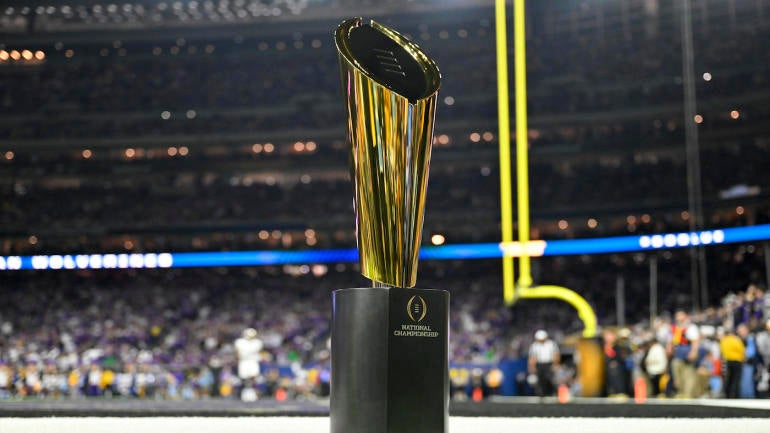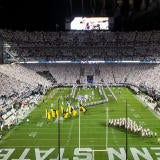
The pause button has been hit on one of the biggest college football stories in 2024, and it's largely flown under the radar.
Earlier this year, the Big Ten and SEC were in the process of what amounted to a hostile takeover of the College Football Playoff. Already succeeding in securing a combined 59% of media rights revenue under the new CFP contract with ESPN, they also socialized the idea of essentially taking over the bracket.
The reaction from within the system was far from positive. The attempted coup peaked -- or hit rock bottom depending on how you view it -- in February with reports the two super conferences were attempting to grab the top two spots in the playoff for their respective champions beginning in 2026 when the new contract goes into effect.
That was in addition to seeking three automatic qualifiers each for the two leagues. Final tally: 10 combined spots between the Big Ten and SEC.
"I didn't agree with it," one administrator in the room at the time told CBS Sports this week. "It would potentially de-legitimize the playoff to some degree. No league has that. No league gives you a lot of [access] because you have money."
Pushback from the rest of college football was so significant that such talk diminished before flaming out altogether. In fact, a settlement of the issue -- perhaps expected when CFP leaders meet again in September -- looks like it will be delayed.
The 10 FBS conferences plus Notre Dame have seemingly agreed to let this season play out under the 12-team format before making any further decisions about structure for 2026 and beyond. Beyond 2026, virtually everything is on the table including possible expansion of the field to 14 and beyond.
"I'm just a humble one of 11," SEC commissioner Greg Sankey said last week. "I thought it would be wise to get through this year. I don't think we should be looking at format before we have a 12-team experience."
Let's have a deeper look at why the once-aggressive talks of expanding the CFP sooner rather than later have cooled.
5+7 model works ... for now: The default playoff setting is the one debuting this season -- a 12-team bracket with the five highest-ranked conference champions earning an automatic berth. The top four teams earn a first-round bye, which leaves seven at-large teams. For context, here's how a 12-team field would have looked last season.
"I think the selection committee and the CFP Management Committee [commissioners] have to cope with what that means, those seven non-conference champion teams that participate," Sankey said.
With the dissolution of the Pac-12, those five AQs at the top have essentially become the Power Four champions (Big Ten, SEC, ACC, Big 12) + 1. In most years, that "+1" looks like it may eventually become the Mountain West champion should the conference add Oregon State and Washington State as full members in 2026.
The ongoing issue is those seven at-large teams. SEC power brokers have already given some thought on which way those should go.
Big Ten and SEC make out in any scenario: Sankey remains on record as saying he has no problem with all at-large teams, and it's easy to see why he's taken that stance. Big Ten and SEC teams will fill the bracket no matter the format. Why rush into formalizing it? If the current 12-team format was in place last season, 10 of the 14 teams would have been from those two conferences.
In making their case for that 58% of the revenue, the Big Ten and SEC noted that they had accounted for 29 of the 40 CFP berths (72.5%) in the first 10 years (2014-2023). Yet, they only received 33% of the revenue. In this expansion era, they're going to get paid ... it's just a matter of how much.
"To start talking about expanding it to whatever number, let's see how successful this is," said Mississippi State president Mark Keenum, chair of the CFP Board of Managers. "I think [the expanded playoff] will be extremely successful. It has been well received by our fan base around the country. If our coaches like it, the format, the dates [that's good]. You're always going to think about options for making it better and expanding. But, my goodness, it hasn't even started yet."
House v. NCAA settlement: College athletics was driven into a ditch last month by the House vs. NCAA settlement. That distracted everyone in the college space. For all the legal levers yet to be pulled in the settlement, it was easy to push the CFP's future into the background. Actually, every other NCAA/collegiate discussion is secondary at this point with pay-for-play, unionization and wildly impacted budgets all in play.
The settlement and its implications were the talk of SEC spring meetings last week in Destin, Florida. No one had definitive answers. There was plenty of hand-wringing. The uncertainly is likely to last throughout this year, at least.
Forget the CFP. There might not be an NCAA by this time next year.
Litigation: The Florida attorney general continues an anti-trust investigation into the CFP after Florida State was excluded from the 2023 field. Remember?
The AG is seeking records -- if any exist -- on how the 13-person selection committee arrived at its final decision to leave out an undefeated Power Five conference champion. This comes at a time when veteran CFP executive director Bill Hancock is stepping down, being replaced by Air Force Academy superintendent Richard Clark.
Imagine having that paperwork sitting on your desk during your first days in office.
Yeah, the action is probably petty, frivolous and grandstanding, but these days you ignore such litigation at your own risk. CBS Sports previously reported at least one of those selection committee members didn't think FSU could win without injured quarterback Jordan Travis.
Selection committee criteria states it is allowed to consider the "unavailability of key players … that likely will affect its postseason performance."
Sure, but should it when that team is 13-0 and won its conference without the star quarterback at the end of the season?
It was later revealed members of the selection committee were assigned security after threats from FSU fans.
Conference realignment: Why address CFP structure and format when college football as a whole may not be done with realignment. Florida State's dogged effort to get out of the ACC threatens to trigger the next round of consolidation. FSU's departure would diminish, if not cripple, the league. We've already seen the Pac-12 dissolve; to be fair, however, the conference does have a grant of rights that runs through 2036.
This promises to be a bitter legal battle that could take years. Or not. The next date to watch is Aug. 15 when FSU is required to give the ACC one year's notice of its intention to leave the conference. Clemson, which has filed its own lawsuit to get out of the league, is watching closely. After FSU, North Carolina might be one of the most valued brands for any conference.
How do you decide on automatic qualifiers when you don't know how many conferences will exist?
Opt outs/collective bargaining/unions: The CFP could be impacted by any or all of those factors in the future. We've already told you about the likelihood of top draft choices possibly skipping the playoff games. Opt outs are already an issue among the rank-and-file bowls.
If opt outs become a trend, the CFP may have to do something because losing even one high draft choice impacts the playoff's credibility. A start-up basketball tournament in Las Vegas intends to share NIL money with the players. Could the CFP be moved to do something similar?
















